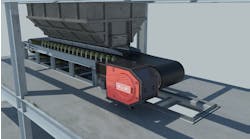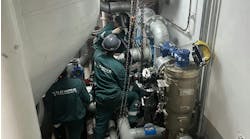By Ariana Hurtado, Editor and Director of Special Reports
The energy industry and its techniques can sometimes be misunderstood and criticized. So, what can industry leaders and trailblazers do to take a deeper dive into this topic and provide the public with factual information and resolve the misconceptions about the offshore oil and gas industry?
Micah Smith, senior partner at McKinsey, shared with Offshore three myths the offshore sector currently faces and how to overcome them.
Myth 1: We don’t need offshore barrels.
"Even though we may see oil demand peak and start to decline in the next decade, oil production is projected to decline by 5-7% on average—much faster than demand decline—requiring new production to come online. The long-duration nature and low-cost position of new offshore production will be needed to meet projected demand for years to come," Smith explained.
Myth 2: Deepwater barrels aren’t advancing the energy transition."The newest deepwater wells coming online are producing oil barrels with some of the lowest carbon intensity globally, with emissions for some newer wells being below 10 CO2e/bbl—about half of the average carbon intensity for global barrels. This low-carbon advantage exists as a result of modern technology, tight emissions controls and the relatively high production volume from each well," he said.
Myth 3: Offshore wells are 5+ year large capital investments that can’t match the current market needs.
Smith said, "Offshore Guyana is the latest example of a basin with ample resources bringing on major production in about three years, when a project of that size used to be a 7+ year endeavor. Cutting-edge FPSO technology pioneered over the last decade in places like Brazil, coupled with increasingly long tiebacks as seen in basins like the Gulf of Mexico [GoM] have made more reserves economically viable in two- to three-year timeframes. As a result, we have seen several projects go through in the past years, even in a low-price environment."
Ramping up production
Exxon Mobil and its partners took final investment decision last month on the Uaru Field development, the fifth in the Stabroek Block offshore Guyana, after obtaining government and regulatory approvals. The $12.7 billion project will feature up to 10 drill centers and 44 production and injection wells tied back to a 250,000-bbl/d FPSO. It is due to start up in 2026. Exxon Mobil is targeting recovery of more than 800 MMbbl of oil.
MODEC is constructing the Errea Wittu FPSO under an EPC contract, with Exxon Mobil working with its suppliers, including nearly 1,000 in Guyana, to help reduce costs and accelerate development. Currently two FPSOs are operating on the block, Liza Destiny and Liza Unity, producing on average 375,000 bbl/d. The Prosperity FPSO for the third development, Payara, should start operations later this year, adding 220,000 bbl/d. The fourth project, Yellowtail, was approved last year and should start service in 2025, contributing a further 250,000 bbl/d.
Exxon Mobil aims to have six FPSOs online by the end of 2027, lifting Guyana’s production capacity above 1.2 MMbbl/d. Partner Hess, in its announcement, sees potential for up to 10 FPSOs to develop the estimated gross discovered recoverable resources across the block to date of more than 11 Bboe.
As another example, bp successfully started oil production in April at its Argos offshore platform in the deepwater US GoM. With a gross production capacity of up to 140,000 bbl/d of oil, Argos is bp’s fifth platform in the GoM and the first new bp-operated production facility in the region since 2008. The company said the semisubmersible platform ultimately will increase bp’s gross operated production capacity in the GoM by an estimated 20%. bp expects to safely and systematically ramp up production from Argos through 2023. bp says Argos is the centerpiece of its Mad Dog Phase 2 project, which extends the life of the supergiant oil field discovered in 1998. It is one of nine high-margin major projects that bp plans start up by the end of 2025 globally.
In the same region, production started on the Vito platform in February. Operated by Shell Offshore Inc., the deepwater Vito platform will produce an estimated 100,000 boe/d at peak. In addition, Vito also serves as the design standard for Shell's Whale project that will feature a 99% replication of the Vito hull and 80% of Vito’s topsides. Shell reached a final investment decision on Whale in 2021 and is scheduled to begin production in 2024.
Last week Petrobras reported that its average production in first-quarter 2023 rose to 2.68 MMboe/d. Main factors were the ramp-up of the P-71 FPSO at the Itapu Field in the presalt Santos Basin; startup of eight new wells in the Campos Basin (including three at Roncador and four at Barracuda, Caratinga, and the Jubarte Cluster); and improved platform production efficiencies. Presalt output for the company set a new monthly record of 2.13 MMboe/d in February and a quarterly record of 2.05 MMboe/d, equivalent to 77% of Petrobras total production (up from 75% in fourth-quarter 2022). Its overall operated production in the quarter was 3.74 MMboe/d.
The FPSO Guanabara MV31 at the presalt Santos Basin in the Mero Field delivered a record 179,000 bbl/d in February, 10 months after startup and from four producing wells. Later in the current quarter, FPSO Almirante Barroso, with a nominal oil production capacity of 150,000 bbl/d, will be the fifth platform to enter service on the giant Búzios Field in the same basin. The platform is moored, and the first production well has been completed.
Norway's project startups
At the start of the year, Rystad Energy reported that development spending offshore Norway will soar in the short-term following the submission of plans for multiple projects late last year. The consultancy estimated the overall cost of greenfield investments proposed in 2022 at $42.7 billion. And those projects sanctioned under Norway’s temporary tax regime should help sustain high gas production on the Norwegian Continental Shelf (NCS) through 2030.
Aker BP’s North Sea Yggdrasil Hub (startup in 2027), Shell’s Phase 3 of Ormen Lange (startup in 2025) and Equinor’s Irpa (startup in 2026), both in the Norwegian Sea, will be major contributors. And NCS liquids production should also be steady going forward, helped above all by the Yggdrasil Hub, Equinor’s Breidablikk (startup in 2025) and Vår Energi’s Balder Future (startup in 2024). But the main suppliers will continue to be major fields sanctioned during the standard tax regime, such as Johan Sverdrup in the North Sea.
The solution
Smith discussed how the offshore industry can resolve these myths and misunderstandings, stating, "As an industry, we need to improve communication around the lower-carbon advantage of offshore oil and the key part these barrels play in providing secure, affordable, and sustainable energy as the world transitions. We need to bring facts—not rhetoric—to the table in discussions with regulators, stakeholders, and the wider public."
05.10.2023




